Results 1 to 6 of 6
-
03-31-2015, 08:07 AM #1Senior Member

- Join Date
- Sep 2014
- Location
- Riyadh, Saudi Arabia
- Posts
- 151
Thanked: 66 How to know the differences between translucent Arkies
How to know the differences between translucent Arkies
lately, I had a growing interest in Arkansas stones, particularly the Translucent Arkies, when I first bought my vintage Translucent Arkansas I tried to flatten it with a new atoma 400 to break-in the diamond plate and to flatten the stone, the diamond plate broke-in within five minutes, but the stone required 2 more days and the use of a coarse industrial-type sandpaper. So I tell you I hated the thing from the beginning, it's slow it is hard to flatten and I thought it is advocated because the old timers were using it, at the end I used it mostly to produce slurry on the softer stones.
Also I noticed a lot of contradicting information scattered all over the web, about how fine the stone is and how hard it is, but the most confusing subject is lapping; some will say that 325 DMT enough others will take it up to 3k sandpaper or lapping films, I know that natural stones very but, some people made it feel like it's a totally different type of stones, and it was !!!
I realized that, when I bought a vintage Norton Bear Translucent Arkansas I found that the translucency is higher so I immediately thought it is finer than my old one, but shortly I recognized that it is not when I started to flatten it, it was really hard, one of the hardest stones I put my hands on, but not nearly as hard as the vintage one, the Bear stone cuts way faster, but not finer, in my opinion it's 8-10k after lapping it up to 1.5k. At this time my interest in Translucent Arkies grown to the point that I bought a new one of Dan's stone, it was Factory Irregular with some inclusion, but certainly cheaper than their regular ones, anyway I lapped it and started testing it immediately, faster than both Bear and the vintage one, but it was less finer than both.
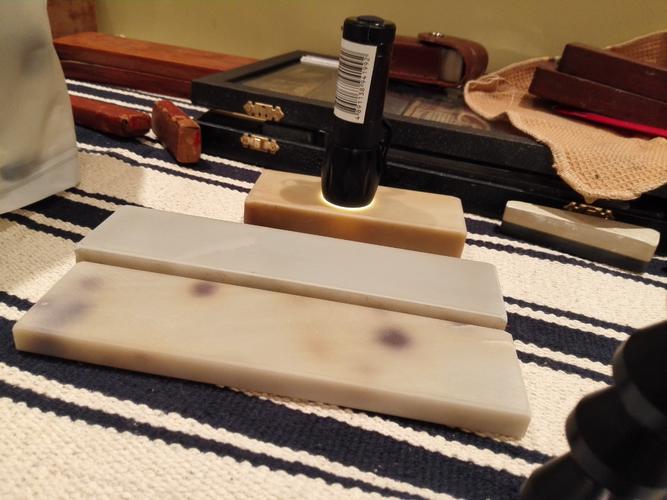
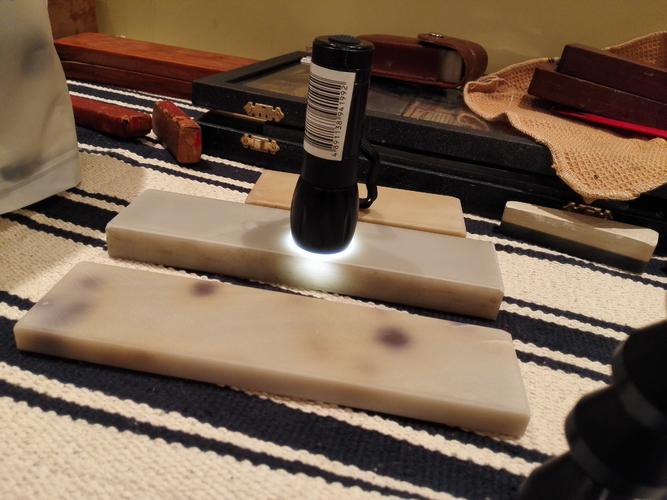
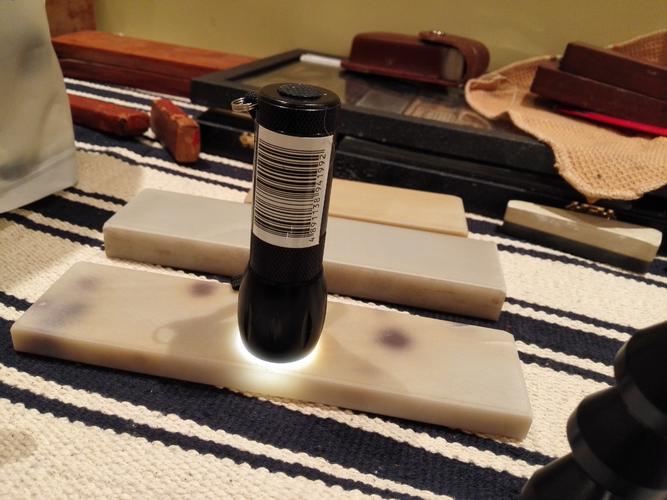
during lapping I noticed, that the vintage one required the minimum to become reflective, once I finish lapping it with the 400 diamond plate it will start to reflect, but the Bear and Dan's required an annoying progression upto 1.5k to remove the scratches from the diamond plate, the I will rub them against each other with their slurry from the diamond plate to bring the reflection.
Finally, I followed the advice of DaveW to use a Carbon Steel knife to break-in the Arkies after lapping it, then I started to finish my razor on the vintage translucent, it toke me less than 200 x strokes to do so using water only, as the usual no singe of meatal removal was visible appear but it have improved an Escher edge wich was very impressive to me, so a declared it to by my finest finisher ever.
I Tried to take photos of the magnified ( X160 ) bevel using my phone ( it was very default to do so, and resulted in bad images )
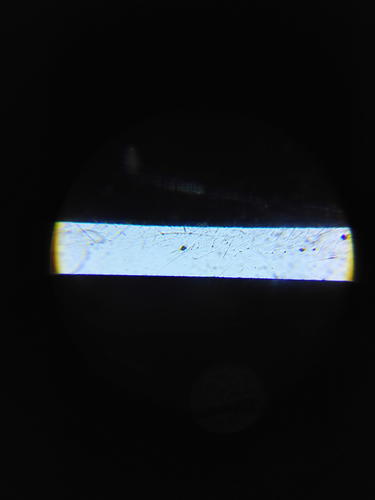
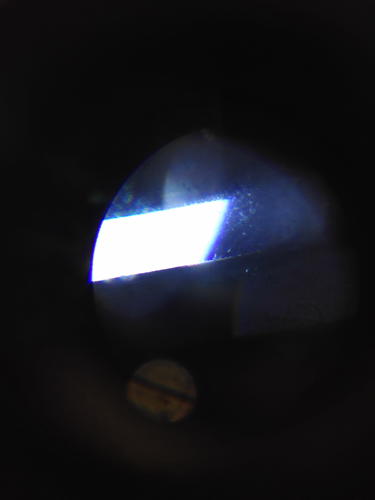
So the question now… How to know which Arkies is finer if the translucency is not a factor ? also is there is source of those extra-extra translucent Arkies ?
Thanks.
-
03-31-2015, 02:36 PM #2Senior Member


- Join Date
- Jul 2011
- Posts
- 2,110
Thanked: 459
I'm not sure what makes one harder than the other (other than to say that the hone itself is bound harder), but I think when all is said and done and they are all broken in well, they should all cut about the same. There is some difference, as you've found out, how finely they cut initially after they've been lapped, and just in my opinion, I prefer stones that are finer after lapping vs. those that take more time to break in. But in the long long run, where you should never lap the stone again (that is, again, just my opinion, i don't like trans stones that have been lapped recently), they should all do about the same.
At least that's been my experience. And "all do about the same" means that they will burnish and slowly cut off scratches left by other more aggressive stones, but once those scratches are mostly removed pretty much cease to cut anything....but haven't measured enough stones to know for sure.
I also don't know if the vintage hardness might have to do with oxidation on the surface or exposure to air instead of being in the ground. Certainly the artificial stones get much harder with age, but I don't know if that happens with the naturals.
Fineness by stones by definition will be specific gravity because the actual abrasive in the stones should be about the same hardness no matter where the stone comes from, so the only variable left is the existence of any tiny voids between particles on the surface of a stone. I once thought I had a stone that was 2.85 specific gravity, but I think I measured it wrong. I believe 2.7 or a little above is about as high as a tightly packed abrasive will go.
I'm not aware of anyone grading arkansas stones as superhard or super fine or any of those things that were labeled on old razor stones. I think you'll have to experiment by buying some, trying them, and keeping the ones you like.
-
03-31-2015, 06:59 PM #3Senior Member



- Join Date
- Apr 2012
- Location
- Diamond Bar, CA
- Posts
- 6,553
Thanked: 3215
So first, lap arks flat with loose Silicone Carbide.
You only need a teaspoon of grit, with a bit of water in a large cookie sheet, to contain the slurry, on flat cement floor, use your body weight and a sharpie to grid mark the stone, pencil washes off on the first lap. It will get it flat in 20-30 mins, it is some work though.
Work your way up in grits up to about 500 grit, then switch to wet and dry paper.
Once flat, polishing goes quickly, or better said, more quickly. Forget the diamond plates, you will just ruin the plates.
You cannot grit rate a hard ark Translucent or Black because the finish is a hazy finish not straight line stria you could compare to. Really shave testing is the only true test.
Prepping with hard steel, burnishing does make the stone perform much differently than not, for razors much finer. A wide chisel or carbon steel cleaver are great for burnishing as there is more to grab on to and add pressure to you strokes. The stone should feel like wet glass when finished.
Quick, they are not, but you should just be finishing on them and 100+ laps are not unusual. I have had some great edges with Japanese Naugras and thin coticule slurry’s. Experiment with slurry.
If it quick-er, you want, add a layer of tape, post 12k finish and do a 10-20 lap micro bevel after making thin slurry with another hard ark.
I have several hard arks, each is a bit different, though I could not say one is finer that another, just different.
An ark edge is unique, keenly biting, but comfortable.
-
04-02-2015, 02:55 AM #4Senior Member

- Join Date
- Sep 2013
- Location
- NW Indiana
- Posts
- 1,060
Thanked: 246
I have an older Pike translucent Ark that behaves considerably different than any of my other Arks. The others I can lap up to 600 or 800 loose grit SiC and then burnish the stone a bit with a fine synth rubbing stone, and take a chisel to it and go to town with no issue and get a pretty high polish on the chisel or razor. The vintage Pike, I can go through the same process, but when I get to the chisel step, this stone sheds particles and starts to cut fast, leaving a bit coarser finish. It basically self-slurries. Very odd.
-
04-02-2015, 04:04 AM #5

yeah I usually lap up to 3000 and still doesn't get good until I use a chisel on it. I believe the secret is you have to hit it with carbon steel.I'm no hone master though
-
04-03-2015, 01:15 AM #6Senior Member

- Join Date
- Sep 2013
- Location
- NW Indiana
- Posts
- 1,060
Thanked: 246
The chisel is a key step to get razor level edges, definitely. It doesn't work on this particular translucent Ark though. It's an odd stone. I'm not sure if it's deteriorated somehow or what. It's hard as hell to lap, just like any other Ark, but then it starts shedding abrasive particles into like a sort of slurry. Cuts fast as all get out but not very useful for finishing a razor.


 LinkBack URL
LinkBack URL About LinkBacks
About LinkBacks






 Reply With Quote
Reply With Quote